Ann Lethbridge's Blog, page 33
December 2, 2010
Books Out
[image error]
The Gamekeeper's Lady
A most forbidden attraction! Frederica Bracewell grew up under a cloud of shame. As an illegitimate child, she was treated by her uncle like a servant. It isn't until she encounters the new gamekeeper that shy, innocent Frederica starts to feel like a true lady…
Lord Robert Mountford has been banished by his family. After a debauched existence, he revels in the simplicity of a gamekeeper's lifestyle. Until temptation strikes! Frederica's plain appearance and stuttering speech are a far cry from the ladies of the ton, but she may just be his undoing… and unmasking!
Purchase in the UK from
Mills & Boon Amazon.co.uk
 Foyles for books
Foyles for booksNot out in paperback in North America until May 2011, it looks as if readers can find it on-line at: Amazon.com for Kindle
 and perhaps Nook etc.
and perhaps Nook etc.[image error] Unmasking Lady Innocent
Spinster Diana Buntin has accepted that handsome Lord James Grey will never look at her as more than a friend. Yet she is tired of waiting to experience passion. Armed with a list of rakes known to specialize in seduction, Diana arranges to meet her first lover at a masked ball—keeping their identities secret and her reputation intact.
But while Diana feels a powerful attraction to her mystery seducer, she also senses that he may not be a stranger after all....
This is an ebook only and can be found on-line at these and other stores:e-Harlequin Undone
 Amazon.co.uk
Amazon.co.uk Kobobooks.com
Kobobooks.com Amazon.com
Amazon.com
And while we are going for all this excitement today don't forget our contest:
[image error]
Today's Featured Author is:
Annie Burrows
Next week will will have December Fashions. Until then, Happy Rambles
December 1, 2010
Contest
Lots of Prizes and lots of fun.
[image error]
For the next 22 days, 22 authors will be giving away prizes, with the grand prize winner selected from all those who enter each day of the contest.
The grand prize is a Kindle!
The more times you enter, the more chances you have of winning the grand prize.
The picture leads to my website where you can find out all the rules and the links to each author's page and contest.
Good luck
November 24, 2010
Searching for Regency London
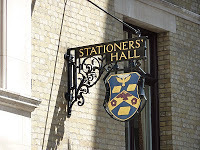
Nearby and of interest to me as a writer is a medieval institution, the Guild of Stationers and their Hall. Stationers' Hall located in Ave Maria Lane, just off Ludgate Hill.
From the Middle Ages, no man was allowed to trade in the City of London unless he resided there and belonged to a Guild, later a livery company. One such was a fraternity or Guild of Stationers (booksellers who copied and sold manuscript books and writing materials and limners who decorated and illustrated them). Each appointed a warden to control and regulate them.
By the early 16th century printers had joined The Stationers' Company and by the mid century the printers had more or less ousted the manuscript trade. In 1557 the Guild received a Royal Charter of Incorporation and in 1559, the right to wear a distinctive livery. They became a livery company, numbered 47 in precedence.
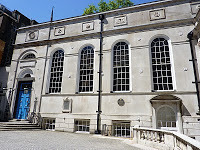 The Stationers' Charter secured them from outside competition, but they had to settle their own internal disputes, which mostly concerned infringements of ownership of 'copies' or what we would now call copyright.
The Stationers' Charter secured them from outside competition, but they had to settle their own internal disputes, which mostly concerned infringements of ownership of 'copies' or what we would now call copyright.
Until the early twentieth century the most usual way of joining the Company was by serving an apprenticeship to a freeman or liveryman. Although the system gradually declined, the Stationers' Company is unusual among livery companies in insisting that its members work in the book or allied trades.
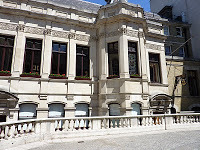 The interior presents much the same appearance today as when it was built although the frontage was radically altered in 1800 to give it an early nineteenth century façade.
The interior presents much the same appearance today as when it was built although the frontage was radically altered in 1800 to give it an early nineteenth century façade.
By 1556 according to Guild rule it was an offence not to present to the Wardens every publication not protected by Royal Grant. A Register of copies became the written record to which claims could be referred and by which disputes as to ownership might be settled. Succeeding Copyright Acts confirmed the Company as the place where copies should be registered 'Entered at Stationers' Hall'.Registration under the Copyright Act of 1911 terminated in December 1923.
Fascinating. Until next time, happy rambles.
November 22, 2010
Being Scotch
person. I do of course mean Scotch whisky (and that too is the correct spelling).
My current work in progress is set in Scotland and part of my plot revolves around a whisky distillery. There are a number of discussions about the origins of uisge beatha, water of life (uisge sounds like usky anglicized to whisky).
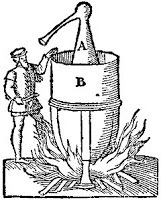 Most experts believe the knowledge of distilling was brought from Ireland by the Scots in the fifth century A.D., along with the Gaelic language. Scotch whisky is made from barley malt and I will not delve into the actual process here.
Most experts believe the knowledge of distilling was brought from Ireland by the Scots in the fifth century A.D., along with the Gaelic language. Scotch whisky is made from barley malt and I will not delve into the actual process here.
Traditionally in the Highlands, whisky was provided before breakfast to sharpen the appetite, since it was seen as both a libation and as a health drink. It was given to infants and children too. It was offered to anyone who crossed a home's threshold as a matter of courtesy at any time of day or night.
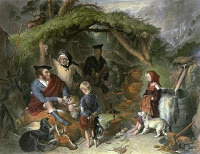 During the Regency there were huge numbers of illicit stills in the Highlands to avoid punishing excise taxes. Considerable quantities were smuggled across the border into England where ardent spirits were taxed at an even higher rate. Highland farmers used their sale of illicit whisky to pay the rents on their land, since often it was their only source of real cash income in addition to what was needed for their own consumption. The rugged Highlands provided great hiding places from the "gaugers" (Excise Officers). And the local populace delighted in the excise officers' failures and mourned their successes.
During the Regency there were huge numbers of illicit stills in the Highlands to avoid punishing excise taxes. Considerable quantities were smuggled across the border into England where ardent spirits were taxed at an even higher rate. Highland farmers used their sale of illicit whisky to pay the rents on their land, since often it was their only source of real cash income in addition to what was needed for their own consumption. The rugged Highlands provided great hiding places from the "gaugers" (Excise Officers). And the local populace delighted in the excise officers' failures and mourned their successes.
When an illegal still was found, the equipment would be smashed and the owner of the still punished – if found.
An Act of Parliament passed in 1814 prohibited any still in the Highlands with a less than 500 gallon capacity. A fantastical size for that period of time. Moreover, thereafter all whisky produced in the Highlands could only be sold in the Highlands, effectively making the legal production and selling of whisky almost impossible. Needless to say it only served to encourage illicit stills
and an increase of smuggling. In 1823 14,000 illicit stills were discovered and smashed, but many more went undiscovered.
Scotsmen with vision knew this had to change and in this year a new act was passed making 40 gallons the minimum size for a still and setting the duty at a reasonable rate. Illicit production slowly dwindled away along with smuggling.
Of course how all this fits in my story has yet to be revealed to me, but I hope you enjoy reading a small snippet from my research. It is nice to know that this ancient Scottish skill has survived to produce one of the world's most popular drams. Slàinte
This post originally appeared on the blog at eHarlequin.com, but I wanted to record it here too, since I may have other posts on this topic.
Until next time, Happy Rambles
November 17, 2010
Searching for Regency London
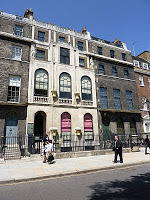
Soane's Museum
This is the house of Sir John Soane, one of England's greatest architects. He was the youngest son of a bricklayer, but at fifteen moved to London as a pupil of the architect George Dance and studied at the Royal Academy. He became a highly successful architect winning the important commission of architect to the Bank of England.
His house, which he deliberately intended as a museum, is on of those places all Regency-philes hanker to visit. It is also the sort of place one might want to visit over and over again, there is so much crammed into such a small space. Soane intended his collection to educate and inspire students and amateurs in painting, architecture and sculpture.
The house is in Lincoln's Inn Fields and he first bought number 12 in 1792 and then moved into number thirteen in 1813, and right from this time he planned it as a museum, finally purchasing number fourteen in 1823.
Visitors were allowed in during his lifetime, but only in good weather. The rooms contain all kinds of artifacts, including a collection of antique marble fragments assembled in and around Rome for Henry Holland, bought on his death by Soane in 1816.
In the picture room are the two original paintings of Hogarth's series A Rake's Progress and An Election. Engravings would be done from the paintings.
It is a very eccentric sort of a place, not at all the typical Regency home, but a fascinating look around a town house. The rooms I enjoyed most were the Library and the dining room and the Drawing Rooms. They held dances in these upstairs rooms when Mrs. Soanes was alive. The rooms were painted in 'Turner's Patent Yellow' a fashionable colour of the day, and had matching curtains and upholstery. The staircases are lovely and take up minimum space.
Personally, I think the man would have ended up on reality tv as a hoarder.
It is difficult to do justice to the house or the museum with only words, but I highly recommend a visit.
Until next time, Happy Rambles. Off to read Georgette Heyer's Reluctant Widow, since someone mentioned it the other day.
What are you reading?
November 14, 2010
Searching for Regency London
Stories are flying out thick and fast from yours truly. This short story, Unmasking Lady Innocent will be available on line on
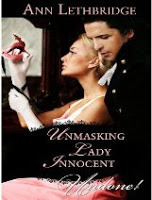 December 1. Another great cover, even if it is an on line one. Just in case you want to know what it is about:
December 1. Another great cover, even if it is an on line one. Just in case you want to know what it is about:Spinster Diana Buntin has accepted that handsome Lord James Grey will never look at her as more than a friend. Yet she is tired of waiting to experience passion. Armed with a list of rakes known to specialize in seduction, Diana arranges to meet her first lover at a masked ball—keeping their identities secret and her reputation intact.
But while Diana feels a powerful attraction to her mystery seducer, she also senses that he may not be a stranger after all....
The Foundling Hospital, Bloomsbury, LondonNot all things Regency leave one with a happy feeling. Certainly my next stop did not. The Foundling Museum is interesting, but sad.
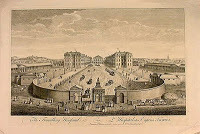 The Foundling Hospital (hospital meaning hospitality to those less fortunate rather than medical facility) was founded in the mid 1700's and continued until the 1920's. It was founded by Thomas Coram who was shocked by the number of dead and dying babies on the streets. Its mission was the education and care of abandoned children.
The Foundling Hospital (hospital meaning hospitality to those less fortunate rather than medical facility) was founded in the mid 1700's and continued until the 1920's. It was founded by Thomas Coram who was shocked by the number of dead and dying babies on the streets. Its mission was the education and care of abandoned children.The children left here were not orphans; rather they were children of women who could not care for them because the fathers had abandoned them. Mothers were interviewed before they were allowed to leave their children who had to be under 1 year-old. The mothers had to be of good character, even if not married, and the child must be their first. Mothers would line up outside the high wrought iron gates for the chance to leave their "unwanted" children, because they knew they would receive better care than they could provide. Both Hogarth and Handel raised funds for the hospital by way of their art.
In 1801 the hero of the Nile and some of his friends the establishment with a visit and stood sponsors to several of the children The names given on this occasion were Baltic Nelson William and Emma Hamilton Hyde Parker &c Up to a very late period the Governors were sometimes in the habit of naming the children after themselves or their friends but it was found to be an inconvenient and objectionable course inasmuch as when they grew to man or womanhood they were apt to lay claim to some affinity of blood with their nomenclators The present practice therefore is for the Treasurer to prepare a list from which the children are named
A register on view at the Museum, records the names of the children admitted, the care they received, including if they were wet nursed or dry (fed bread and water) and their ultimate date of departure at age fourteen either to enter society as apprentices, or the date of their demise. In Georgian times, there were between 200 and 400 children under the care of the hospital.
Dec. 31, 1814,
Children remaining alive, and
on the hospital establishment...........................352
Received in the year ending Dec. 31, 1815...........58
Total....................................................................410
Apprenticed and sent to sea, within the said
year.............................................................26
Died.............................................................13
Children in the hospital, Dec. 31, 1815............192
Children at nurse in the country......................179
...............................................................-----
..................................................................410
Children at nurse in the country, meant children under five who were sent out of the city to be wet nursed and cared for, since the city air was thought to be bad for them
You can find a history of the Hospital in the following book as well as at Londonancestor.com.
The history and objects of the Foundling Hospital: with a memoir of the founder
By John Brownlow, Foundling Hospital (London, England)
Sometimes the mothers would come back for the child when their circumstances improved. Heartrendingly, many times they would discover their child had not survived. Among the artifacts left with the children were lockets and tiny rings, buttons and religious talismen, which were left as a way of identifying their child. They are still held in the Museum.
I found it hard not to feel sad as I walked around, even knowing that these children were better off than those left on the streets or in the workhouses. If you ever have a chance to visit, make sure you take a kleenex or two.
Until next time, Happy Rambles
November 9, 2010
Searching for Regency London
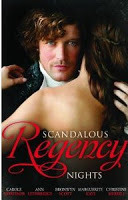
by Ann Lethbridge
I just had to share this one, it comes out in January. This is a collection of HH Undones in Paperback including my first one - The Rakes Intimate Encounter. So if you are a person who prefers paper to e-book, here is your chance to try several Undones which to date were only available on line.
You will of course be hearing more about this one, but I just love the cover and had to share it.
I have been sacrificing chocolate bars to the cover god and she seems to appreciate the love, so here is the result. lol
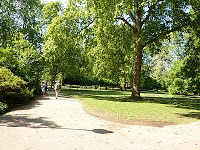 This is the entrance to Russel Square, built by the Duke of Bedford in 1804 and named after his family's surname.
This is the entrance to Russel Square, built by the Duke of Bedford in 1804 and named after his family's surname.The square has been redesigned to go back to its original early nineteenth century layout. Next time I am in London I will spend a bit more time at the square. I was very taken with the Russell Hotel but it is Victorian and therefore unworthy of a picture on my blog.
The portrait painter Thomas Lawrence had a studio at number 65 (1805–1830) Russell Square. Or was it 67, there are some differences depending on which information you read. I am going with 65 since that is what is recorded in Old and New London 1878.
 A note in the Gentleman's Magazine for January, 1818, by the Rev. John Mitford, says:—"We shall never forget the Cossacks, mounted on their small white horses, with their long spears grounded, standing as sentinels at the door of this great painter, whilst he was taking the portrait of their general, Platoff." [Platov]
A note in the Gentleman's Magazine for January, 1818, by the Rev. John Mitford, says:—"We shall never forget the Cossacks, mounted on their small white horses, with their long spears grounded, standing as sentinels at the door of this great painter, whilst he was taking the portrait of their general, Platoff." [Platov]A wonderful mental image. Somehow I have to find a way to put that in a story. Lawrence's house, (seen left) has since been demolished in favour of the Imperial Hotel.
It was also from Bolton House, on the corner of Guilford Street that, on the 21st of June, 1799, George III., with the Queen and several members of the Royal Family, assembled and after partaking of a cold collation, proceeded to view the nearby Foundling Hospital. I will be posting about the hospital next.
That is all for today, until next time, Happy Rambles.
November 4, 2010
Regency Fashion for November
I can't quite believe how quickly things are rushing by. Almost time for another newsletter, so if you haven't signed up, do so waaay at the bottom of the blog.
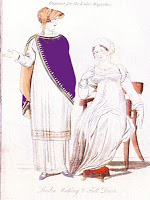 From the November 1809Ladies Monthly Museum
From the November 1809Ladies Monthly Museum Walking Dress
A short petticoat and vest of fine cambric of India muslin, made whole in front, and laced up behind; it is finished with a collar, edged with rich antique lace: the dress is bordered with a colored or worked border. A bonnet of amber velvet or satin, with a small front, and tassels on each side. Roman cloak of purple velvet, and with amber sarcenet: the cloak is ornamented with a gold trimming, and fastened on the right shoulder with a broach or clasp. Purple shoes or half boots.
Full Dress
A dress composed of lacenett, spotted or worked in stripes: --a white satin body and petticoat; the front made high and square, and worked in chenille; sleeves of entire lace. Headdress, a lace handkerchief or hood, ornamented in front with two ostrich feathers. Necklace of gold chain, with cornelian clasp: earings to correspond: white shoes and gloves.
I love the idea of the Roman cloak of purple and the amber bonnet.
Next week we will be back to our tour of Regency London. Until then Happy Rambles.
October 28, 2010
Winners
Without further ado....drum roll.
 My random name generator picked the following names from the cyberspace hat.
My random name generator picked the following names from the cyberspace hat.Kitty and Johanna R Jochum.
I just wish I had enough books for everyone. If you two ladies would email me at ann @ annlethbridge dot com with your addresses I can have these books winging off to you.
Next week is the beginning of November and we will have our usual fashion show.
Until then, Happy Rambles
October 21, 2010
Contest - Win a book
I don't often d
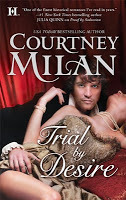 o contests, this blog being more about Regency Research, but there is something special going on inside the book pictured here. Trial by Desire is by USA today best selling author Courtney Milan and is set in 1838. Don't you just love that cover. I swear sexy dude is looking right at me.
o contests, this blog being more about Regency Research, but there is something special going on inside the book pictured here. Trial by Desire is by USA today best selling author Courtney Milan and is set in 1838. Don't you just love that cover. I swear sexy dude is looking right at me.It's a great story. Well, that goes without saying. But also it contains a present from me and some of the other Harlequin Historical authors (or rather from our publisher). A choice of two free books!!
Including Wicked Rake, Defiant Mistress, by ---- Ann Lethbridge. If you haven't read it yet, here is your chance. And if you prefer to pick one of the other books, that's good too!
Here is the deal. You tell me why you like to read Historical Romance, no later than the end of Wednesday October 27, and I will draw from all the answers and send the two winners a copy of Courtney' delicious book. And then you can send off to Harlequin for two free books.
I will post the winners on Thursday October 28, and the winners can send me the necessary information to claim their prize.
Questions? No?
Step up, step up, folks, for a total a three free books. Not a lot of writing required, just a couple of lines.
Next time on Regency Ramble we resume our search for Regency London. Don't forget your walking shoes or better yet, half boots of yellow kid.
Until next time, Happy Rambles.




